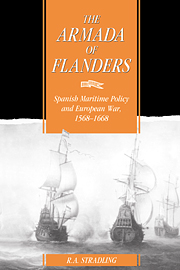
-
Select format
-
- Publisher:
- Cambridge University Press
- Publication date:
- September 2009
- February 1992
- ISBN:
- 9780511470677
- 9780521405348
- 9780521525121
- Dimensions:
- (228 x 152 mm)
- Weight & Pages:
- 0.635kg, 300 Pages
- Dimensions:
- (228 x 152 mm)
- Weight & Pages:
- 0.46kg, 300 Pages
You may already have access via personal or institutional login- Subjects:
- Area Studies, European History after 1450, History, European Studies
Book description
The Flanders armada, took shape in response to the use of seapower by the Dutch rebels, and evolved into the most effective unit in Spain's defence establishment. In combination with its privateering auxiliaries, this elite striking force dominated the North Sea for some twenty years (1625–45), and campaigned also in the Mediterranean and Atlantic theatres of war. Yet its contribution to the tenacious survival of Spanish hegemony has never before been assessed. A narrative of the armada's fighting record over the century of its meaningful existence is presented with constant reference to the strategic-logistical context and analysis of policymaking in Madrid. Attention is paid to the political significance of maritime policy, and particularly the relationship between Madrid and its subordinate headquarters in Brussels; the infrastructure of the armada; the ships themselves, above all the revolutionary but elusive 'frigate'; the social hierarchy of crews and commanders; and details of administration and financing.
Contents
Metrics
Altmetric attention score
Full text views
Full text views help Loading metrics...
Loading metrics...
* Views captured on Cambridge Core between #date#. This data will be updated every 24 hours.
Usage data cannot currently be displayed.
Accessibility standard: Unknown
Why this information is here
This section outlines the accessibility features of this content - including support for screen readers, full keyboard navigation and high-contrast display options. This may not be relevant for you.
Accessibility Information
Accessibility compliance for the PDF of this book is currently unknown and may be updated in the future.


